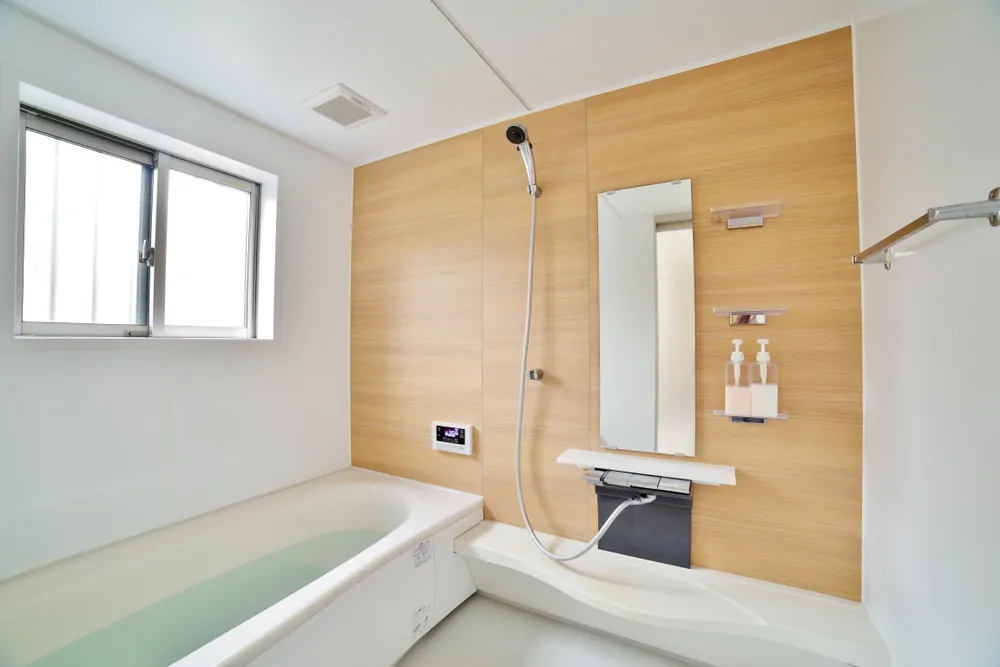Bathrooms are universal, but the specifics often vary according to the culture. Normal is relative, and it tends to be extremely helpful when encountering new cultures to first explore and examine their unique norms.
As you might expect, Japanese bathroom design reflects the culture’s values of cleanliness, harmony, and organization. It also reflects the culture’s history of public baths.
Here’s a guide to a typical Japanese bathroom, including its arrangement and standard features, to help newcomers reclassify the potentially peculiar to become more familiar.
Layout
First-time tourists in Japan may be initially surprised at the layout of a Japanese bathroom. It’s a critical thing that separates Japanese and Western bathrooms.
Most noticeably, each bathroom task and item is distributed differently, with separate areas for changing, showering/bathing, and using the toilet.
Separate Spaces
Traditional public baths have influenced how a Japanese home bathroom is designed today. They’re designed to have a fully separated wet room for showering and bathing.
The wet washing area is closed off from the changing area, which is also separate from the toilet. Although separating the wet room from the dry sink and vanity area and the closed-off toilet space may seem strange at first, dedicating different spaces to each set of tasks makes perfect sense to Japanese people.
With distinct areas for using the toilet, changing, and personal cleaning and soaking, the divided nature of a Japanese bathroom is a long-held tradition. The preference for it has endured despite the notorious space constraints in many Japanese cities.
It’s not unusual for a several-bedroom Japanese home to have just one bathing area, a single toilet room, one sink and changing space for all residents to share. Western homes tend to have several bathrooms, each consisting of multiple elements in a shared room.
Keeping Things Hygienic
A long, hot soak is a popular nighttime ritual in Japan. Baths are a common way to relax, so families often take turns soaking at the end of the day. With a dedicated bathing space, no one’s bath will be interrupted by toilet-related needs.
It also makes hygienic sense to separate the wet cleaning area from the dry (and occasionally smelly) toilet space. In fact, for those accustomed to a Japanese bathroom, seeing the toilet in a bathing area feels a bit unclean, not to mention stressful. Who can relax if they’re worried about their health?
Today, there are some Japanese bathrooms designed with combined features. However, for most Japanese people, the need for totally separate bathing and toilet spaces is non-negotiable. This can work to your advantage if you’re living in Japan – apartments with combined bathrooms are typically cheaper than those with a Japanese setup.
Japanese Bathing Culture
It’s common practice at a public bath or hot springs to shower first, then bathe. Bathing isn’t actually intended for cleaning yourself but rather for a warm, relaxing soak.
This bathing continues in Japanese homes. Cleaning yourself before bathing in a Japanese bathroom helps conserve water by keeping it clean for reuse.
Reuse, you say? Yes! It’s entirely typical to have family members all take a soak in the same bathwater. Japanese tubs frequently come with a cover to help keep the water warm (and to keep children from falling in).
And when we say soak, we mean it – the standard Japanese tub is 68.5 cm or 27″ deep. That’s deep enough to have the water cover your shoulders while seated.
A deep Japanese bathtub will typically hold water to be reheated and reused by multiple family members for several days. And each time the tub is used, the bather first showers.
It’s also not uncommon to step out of the bath for a thorough, mid-soak shower, carefully keeping the suds out of the tub. After rinsing, many will return to the tub for a final soak. When finished, the water is covered and saved for the next person.
Techy Tools
The technology involved in a standard Japanese bathroom may surprise newcomers. These elements are designed to make the experience easier, so don’t let them be intimidating!
Enhanced Toilets
Perhaps the most noticeable difference foreigners will likely encounter is a technologically advanced toilet.
Japanese toilets are often equipped with digitally-operated bidet features that can usually be precisely programmed, depending on the manufacturer.
Some settings may include:
- Oshiri (おしり) is meant for your backside and shoots a direct water stream to wash the area clean thoroughly.
- Yawaraka (やわらか) is a softer spray designed to deliver a gentler wash, also directed towards the back end.
- Bidet (ビデ) uses a wider, more dispersed spray wash that can clean both front and back.
- Stop is usually a square button or the kanji symbol 止.
Digital Tubs
A modern Japanese bathroom will usually have built-in programs to fill and heat the bath water. A corresponding set of controls is not uncommon beside the tub or near the door.
Tech-based tub controls are a fairly standard feature for a typical Japanese bathroom today. The bathtub’s modern electronic control panel provides an effective way to precisely control the bathwater’s heat level through a built-in, button-operated insulation system.
Organization
First-time visitors to Japan may be intrigued to notice a number of specific shower tools and accessories. Though the number of accessories may seem over the top, most of them do serve a purpose in keeping the space clean and your shower safe.
A tried and true set of personal bathing items has become standard for successfully showering in Japan. These items are useful for maintaining order and functionality in tight spaces while showering, bathing, etc.
The following products are recommended for an improved experience in a Japanese bathroom:
- Anti-slip floor mats are essential for reducing the hazard of slip-and-fall accidents in the washroom. Use it anytime you’re in the bathing room so you can get around safely and comfortably.
- Small plastic stools are generally helpful for safely and comfortably showering in the wash area before or between soaks in the tub. It’s common to sit while showering.
- Shower caddies and baskets are commonly used to provide handy spaces for shower supplies like soaps and shampoos. These tools aid in keeping the small area tidy.
- Waterproof sandals or slippers are useful for visiting the toilet room since removing your shoes inside a Japanese home is customary.
Avoid the excess buildup of dirt and grime by regularly rinsing shower supplies at the end of each use. This will help to maintain a clean, mold- and mildew-free space for longer.
Cleanliness
Effective cleaning strategies are imperative to prevent mold and mildew from accumulating in a Japanese bathroom.
The bathing area of a Japanese bathroom tends to be a very warm and wet space. No amount of ventilation will be enough to fully eliminate all the moisture that frequently collects there, especially following hot showers and long, luxurious soaks in the tub. But regularly running the room fan after each use will increase the airflow and help keep the area as dry as possible.
Also, it’s beneficial to rinse the hot surfaces with cold water immediately following a steamy shower and bath. This will help clear steam from the room and prevent mold colonies, which tend to prefer a warmer temperature.
It’s also helpful to spray the area on a regular basis with an eco-friendly cleaner, such as diluted vinegar, to fight off any mold-causing fungi from growing. You should also perform a thorough, hands-on scrub semi-regularly.
The separate areas of a Japanese bathroom offer the added bonus of easier cleaning within the dry spaces. With separate dry rooms, the toilet and vanity areas aren’t needlessly exposed to extreme moisture and temperature changes with each shower and bath. This makes their upkeep much more straightforward, especially compared to combined Western bathrooms.
Simpler Than It Looks
Many visitors to Japan are confused, or even a little embarrassed, by their first trip to a bathroom in Japan. Everyone’s gotta go sometimes, but it turns out there are a lot of different ways to do it.
With a layout that disperses each of the different bathroom tasks into entirely separate spaces, bathing and showering in a Japanese bathroom is a more compartmentalized practice. Traditionally, with this distribution, the needs of everyone in the home are better able to be met with less interruption and waste.
By familiarizing yourself with the basics of a Japanese bathroom, you’ll have a much more comfortable time in more ways than one!





Leave a Comment